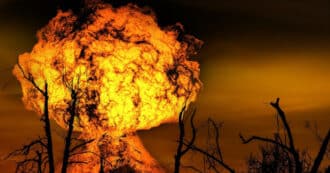By Aryeh Ronay – Readers of Genesis 5 often wonder about its deeper meaning. The chapter opens with: “This is the book of the generations of Adam. In the day that God created man, in the likeness of God made he him.” (Genesis, King James Version).
Adam is described as being created “in the likeness of God.” As Chief Rabbi Emeritus Lord Jonathan Sacks, may his memory be blessed, comments in Eco Bible, being created in the image of God means we have “the capacity to alter and possibly endanger the natural world.” Rabbi Sacks continues, “If we see in our roles as masters of the earth a unique opportunity to truly serve and care for the planet, its creatures and its resources, then we can reclaim our status as stewards of the world, and raise our new and future generations in an environment much closer to that of Eden.”
With great power comes great opportunity.
Equality in Genesis 5
Genesis 5 continues: “He created them male and female; and blessed them, and called their name Adam, in the day when they were created.” (Genesis 5:2). The rabbis address this strange language of “he created them male and female… and called their name Adam” by explaining Adam as being created originally both male and female. This is important, because the King James Version translates Eve as coming from the “rib” of Adam (Genesis 2:22), but she could instead be translated as coming from the “side” of Adam, due to an ambiguity in the original Hebrew text. In other words, Eve might not have come from a piece of Adam, but from his side, as an equal.
Recognizing the primordial equality of men and women can help repair our relationship with the Earth, by helping us shift from an attitude of domination to an attitude of cooperation.
There is a long list of people in this chapter, 10 to be precise, stretching from Adam to Noah. Each person is described as fathering one prominent son, and then having “sons and daughters”. Why does this chapter mention “sons and daughters”, if the only one who is mentioned by name is one son in each generation?
Perhaps this reveals an error in their way of thinking. Each person had sons and daughters, but they focused all their attention on only one child. This theme is repeated throughout the book of Genesis: with Isaac and Ishmael, Jacob and Esau and Joseph and his brothers. Over and over again, one child is favored over another, and the results are disastrous.
Even if we’ve come a long way in increasing equality between men and women, our planet is still plagued by the belief that certain people deserve more than others. The result is that a small percentage of the population is consuming a majority of the Earth’s resources.
We need to think more deeply about how we can share the abundance of the Earth fairly, focusing not just on the top 1%, but on all the “sons and daughters” of humanity.
Adam and His Descendants In Genesis 5
If you consider how many generations Adam saw during the years that he lived, you’ll find something interesting. Adam, similar to other other people described in the Bible, lived long enough to see eight generations that came after him. Imagine if we could live to see the next eight generations. Would we act differently?
Today, we see the youngest generation is at the forefront of addressing climate change and other global issues. This is often the case. The youngest generation is the most motivated to make the world better, because they are the ones who are inheriting it next. Unfortunately, as we grow older, we often begin to lose steam. The closer people come to death, the less value they may see in improving life. After all, they only have so much more time to enjoy it.
What if we were able to think like Adam could about the next eight generations? Maybe, instead of losing steam as we got older, we would gain momentum. If we see ourselves connected to the next eight generations after us, there would be no limit to what we would try and accomplish.
Enoch Walked With God
The figures in this section all lived very long lives (between 800 and 970 years), except for Enoch, who lived 365 years. Enoch is described as someone who “walked with God” (Genesis 5:24), a term reserved for only the most righteous of people. If Enoch was so righteous, why was his life so much shorter?
According to the Midrash, a commentary by Jewish rabbis on the Bible that was compiled about 1,200 years ago, Enoch was righteous, but prone to be drawn to wickedness, so God took his life earlier than the people who preceded and followed him. By this account, God taking Enoch’s life early was not a curse but a blessing.
We typically think of longevity as a blessing. Humanity has been obsessed from time immemorial with “fountains of youth” and “trees of life” in our pursuit of immortality. Thinking about the growing population and rising life-expectancy, there are also challenges with more people living more years.
Our planet is already being pushed to the limit. God forbid that people should not live full lives, but we do need to consider how our lives are being lived. As Mahatma Gandhi said “The world has enough for everyone’s need, but not enough for everyone’s greed.”
Enoch’s relatively shorter life reminds us that more important than the number of years in our life, is what we do with them.
To Live Passively or Proactively?
Over and over again we read about people living a certain number of years and then dying. We read how “Adam lived 930 years, and then he died…Seth lived 912 years, and then he died…Enosh lived 905 years and he died… Kenan lived 910 years and he died… Mahalalel lived 895 years and he died….Jared lived 962 years and he died… Methuselah lived 969 years, and he died… Lamech lived 777 years, and he died.”
What does it mean for each of these people to live, give birth to children and then die? Besides Enoch, it seems as though none of these characters did anything significant. It almost seems as if they are only here to connect Adam to his great, great, etc. grandchild, Noah. Noah saved his family and many animals species from ecological destruction, while his ancestors seemed to have passively participated in the degeneration of their time.
This should be a wake up call for all of us. Will we be like Noah’s ancestors, passive in our lifetimes, living a certain number of years and then dying? Or will we be like Noah, proactive and doing the best we can to save as many creatures as we can from environmental catastrophe? The choice is ours.
Noah Relieved the “Curse of the Earth”
In chapter three of Genesis, the ground is cursed and humanity along with it: “Cursed be the ground because of you; By toil shall you eat of it all the days of your life” (Genesis 3:17). But in chapter five, ten generations later, we find relief from this curse through Noah: “And he called his name Noah, saying, ‘This one will give us rest from our work and from the toil of our hands from the ground, which the Lord has cursed’” (Genesis 5:29). How did Noah help relieve the curse of the ground?
The Midrash provides an answer:
“'[Noah] will ease (ינחמנו) the toil of our hands.’ For until Noah came, people had no agricultural instruments and those are what he prepared for them. The earth had brought forth thorns and thistles when they sowed wheat in consequence of the curse imposed upon the first man, Adam: in the days of Noah, however, this ceased.”
According to the Midrash, besides building an ark that saved innumerable species from extinction, Noah also revolutionized agriculture by creating new tools to make working the ground easier. Noah’s agricultural innovations can be understood on a broader level as part of the first agricultural revolution. This was when humanity shifted from hunter/gatherers to farmers who domesticated plants and used tools to ease their cultivation.
The second agricultural revolution occurred within the past 400 years as technology advanced, enabling the creation of mechanical plows to improve crop yield, and steamships to that facilitated faster transportation of agricultural goods.
The third agricultural revolution occurred in the past 70 years. This revolution involved the development and application of fertilizers and pesticides, and more recently, the widespread use of genetically modified organisms.
With each of these advances in agriculture came problems as well. The third agricultural revolution, for example, threatens to push the land to its limit, and exhaust our natural resources. How can agriculture evolve to meet our needs without our needs surpassing the planet’s capacities? Perhaps we need a fourth agricultural revolution.
Noah and The Flood
The prophet Isiah gives a prophecy of hope in the Bible: “The earth will be filled with consciousness of God as water covers the ocean floor.” (Isaiah 11:9).
In Zoroastrianism, Christianity, Judaism and Hinduism, there is a belief in a world to come that will be better than this one.
According to the Jewish mystical tradition, this better world to come will also feature a flood, but it will be a flood of divine consciousness and care for creation, not a flood of violence and destructive water as Noah experienced.
Perhaps a fourth agricultural revolution could help create a better world in our lifetimes. Perhaps we could work towards an agricultural revolution that is not just technological, but also spiritual, to help us to reconnect with the Earth in a healthy, sustainable way.
Drawing on indigenous farming techniques, permaculture, modern technology, and our rich cultural heritages, we can create a system of agriculture in sync with both our needs and the rhythms of the Earth. We can build societies that will cater to the next eight generations, and the next 800 generations. We don’t have to build an ark to escape the coming flood of Divine and ecological consciousness, we just have to learn how to channel the waters in a way that we can all enjoy our planet’s abundance.
* Featured image source








